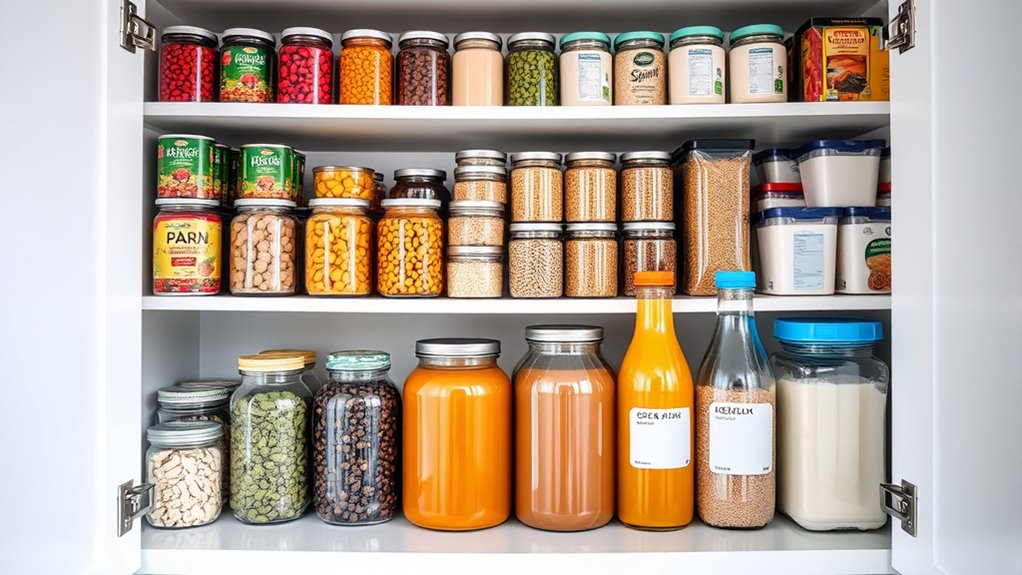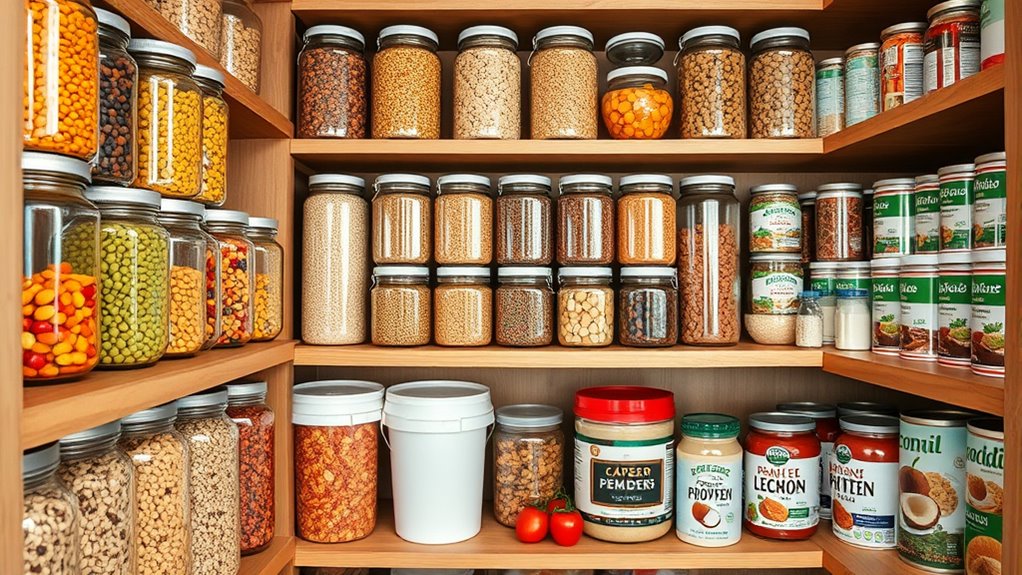To build a 3-day plant-based, shelf-stable emergency pantry, stock up on canned vegetables, beans, lentils, and grains like rice or quinoa. Add dried fruits, nuts, and seeds for snacks, and keep versatile ingredients like canned tomatoes and oats for quick meals. Use airtight, labeled containers for organization. Keep essential tools nearby, and plan simple recipes like bean bowls or vegetable stir-fries to stay nourished. Keep exploring to learn how to maximize your pantry’s setup and efficiency.
Key Takeaways
- Select a variety of shelf-stable, plant-based proteins like canned beans, lentils, and chickpeas for balanced nutrition.
- Include versatile grains such as rice, quinoa, and oats, along with dried fruits and nuts for energy and snacks.
- Use airtight, labeled containers to organize and maintain freshness of all pantry items for quick access.
- Prioritize easy-to-prepare ingredients that require minimal cooking, like canned vegetables and pre-cooked grains.
- Regularly check expiration dates and rotate supplies to ensure freshness during the 3-day emergency period.

Have you ever wondered what essentials you should keep on hand for an emergency? Building a 3-day emergency pantry that’s 100% plant-based and shelf-stable might seem tricky at first, but with the right approach, it’s straightforward. The key is to focus on versatile, nutrient-dense foods that don’t require refrigeration or complex preparation. When it comes to meal prep during a stressful situation, simplicity is your best friend. You want foods that are easy to combine, quick to prepare, and satisfying enough to keep your energy up. To achieve this, you need effective storage solutions that maximize space and keep your food fresh and accessible. Clear, airtight containers work wonders—they prevent spoilage, keep pests out, and make it easy to see what you have at a glance. Stackable jars or bins are excellent for organizing your pantry, helping you stay on top of supplies without clutter.
Start with canned or jarred vegetables like tomatoes, corn, or green beans. These are reliable staples that add flavor and nutrition to your meals. Pair them with shelf-stable plant-based proteins such as lentils, chickpeas, or beans, which come in cans or vacuum-sealed pouches. These options are lightweight, long-lasting, and easy to cook with minimal effort—just drain and heat or toss into a salad. Whole grains like rice, quinoa, or oats are also essential, providing energy and versatility. Keep a variety of these in airtight containers to prevent moisture from ruining them. Dried fruits, nuts, and seeds make for quick snacks or additions to meals, boosting both flavor and nutrition.
When planning your meal prep, think about combining these ingredients into simple dishes. For example, you could make a hearty bean and rice bowl, a vegetable stir-fry, or a quick pasta with tomato sauce. Having pre-measured portions stored in small, labeled containers helps streamline meal prep during emergencies. Label everything clearly, so you know what’s inside without rummaging through your storage. Consider using stackable, modular storage solutions that fit neatly on shelves, making it easy to access what you need. Keep a small, portable can opener and utensils nearby, so you’re always ready to prepare a meal quickly.
Frequently Asked Questions
How Do I Ensure Nutritional Balance in My Plant-Based Emergency Pantry?
To guarantee nutritional balance, focus on including a variety of plant-based protein sources like beans, lentils, and nuts. Incorporate diverse vitamin sources such as dried fruits, fortified cereals, and dehydrated vegetables. You should also think about adding seeds like chia or flax for omega-3s. By mixing these options, you’ll cover essential nutrients and maintain a balanced diet during an emergency, even with shelf-stable supplies.
What Are the Best Storage Containers for Shelf-Stable Plant Foods?
Think of your storage as a fortress for your plant-based foods. You’ll want airtight containers to lock out moisture and pests, keeping everything fresh. Stackable bins are perfect for saving space and organizing your pantry efficiently. Choose clear containers so you can easily see what’s inside. Durable, BPA-free options are best. With these containers, your shelf-stable plant foods stay fresh and ready for any emergency, like a well-guarded treasure chest.
How Often Should I Rotate or Update My Emergency Pantry Supplies?
You should check your emergency pantry regularly, ideally every 3 to 6 months. This helps you keep track of expiration dates and guarantee ideal storage conditions. Rotate supplies so newer items replace older ones, preventing spoilage and waste. Proper storage conditions—cool, dry, and airtight—extend shelf life. Staying proactive ensures you always have fresh, safe, plant-based foods ready when you need them in an emergency.
Can I Prepare Meals Directly From Shelf-Stable Items Without Refrigeration?
They say “a stitch in time saves nine,” and that’s true for meal prep from shelf-stable items. You can prepare meals directly without refrigeration, thanks to their shelf stability. Focus on versatile ingredients like canned beans, grains, and dried fruits. These allow you to whip up nutritious, plant-based dishes on the spot, ensuring you’re ready for any emergency without needing refrigeration or complex cooking equipment.
Are There Allergen Considerations When Choosing Plant-Based Emergency Foods?
When choosing plant-based emergency foods, you should consider allergen concerns like gluten sensitivities and nut allergies. Always read labels carefully to avoid ingredients that might trigger reactions. Look for clearly marked allergen-free options, and consider packing alternatives if you have specific sensitivities. Being vigilant helps guarantee your emergency pantry is safe for you and anyone else who might need to use it during a crisis.
Conclusion
With this 3-day plant-based emergency pantry, you’re well-prepared for any situation. Stocking shelf-stable, nourishing foods guarantees you won’t be caught off guard. Remember, it’s better to be safe than sorry, so keep your supplies updated and ready to go. Flexibility is key—adapt your stash to your tastes and needs. When trouble strikes, you’ll have peace of mind knowing you’ve got a solid, plant-powered backup plan in place.










